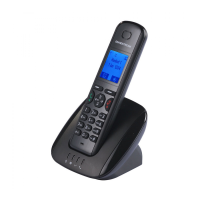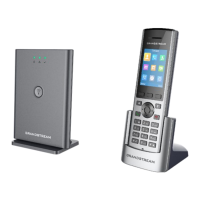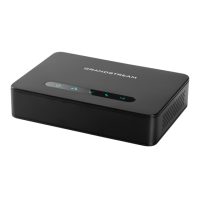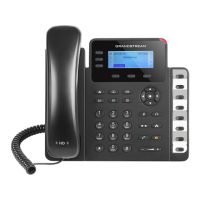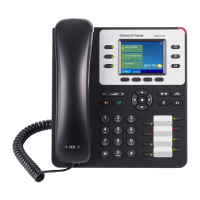UCM6200 Series User Manual
When FXO port answers the call, FXS may send a Polarity Reversal. If this interval is
shorter than the value of “Polarity on Answer Delay”, the Polarity Reversal will be
ignored. Otherwise, the FXO will onhook to disconnect the call. The default setting is
600ms.
Current
Disconnect
Threshold (ms)
This is the periodic time (in ms) that the UCM6200 will use to check on a voltage drop
in the line. The default setting is 200. The valid range is 50 to 3000.
Configure the ring timeout (in ms). Trunk (FXO) devices must have a timeout to
determine if there was a hangup before the line is answered. This value can be used
to configure how long it takes before the UCM6200 considers a non-ringing line with
hangup activity. The default setting is 8000.
Configure the RX gain for the receiving channel of analog FXO port. The valid range
is from -13.5 (dB) to + 12.0 (dB). The default setting is 0.
Configure the TX gain for the transmitting channel of analog FXO port. The valid range
is from -13.5 (dB) to + 12.0 (dB). The default setting is 0.
Configure to enable CallerID detection. The default setting is “Yes”.
Select the Caller ID scheme for this trunk. The default setting is “Bellcore/Telcordia”.
Configure the time interval between off-hook and first dialed digit for outbound calls.
Enable automatic recording for the calls using this trunk. The default setting is
disabled. The recording files can be accessed under web GUI->CDR->Recording
Files.
If selected, the trunk will be disabled.
This is to implement analog trunk outbound line selection strategy. Three options are
available:
• Ascend
When the call goes out from this analog trunk, it will always try to use the first idle
FXO port. The port order that the call will use to go out would be port 1->port 2-
>port 10->port 16. Every time it will start with port 1 (if it's idle).
• Poll
When the call goes out from this analog trunk, it will use the port that is not used
last time. And it will always use the port in the order of port 1->2->10->16->1->2-
>10->16->1->2->10->16..., following the last port being used.
• Descend
When the call goes out from this analog trunk, it will always try to use the last idle
FXO port. The port order that the call will use to go out would be port 16->port 10-
>port 2->port 1. Every time it will start with port 16 (if it's idle).
The default setting is “Ascend” mode.
